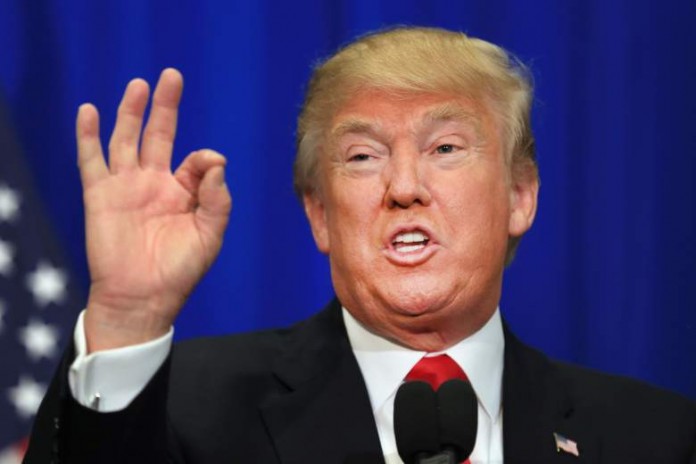
Presidential politics is, at its core, all about math. Nowhere is that more true than in the fight for delegates before this summer’s Republican National Convention. And the delegate math on the verge of the Super Tuesday vote is near-conclusive: Donald Trump will be extremely close to the 1,237 delegates he needs to formally claim the party’s nomination by the end of the primary process.
Let’s do the math – or, rather, let’s do the math forwarded to me by a number-cruncher who counts himself as a card-carrying member of the GOP establishment but who also regards Trump’s nomination as nearly inevitable.
(Side note: These are back-of-the-envelope calculations. Each state allocates delegates differently, so to understand the broad sweep of where the delegate count will end up, you have to make some rough assumptions. If you want detailed analysis of how each state does it, check out the invaluable Frontloading HQ website.)
After four states voted, Trump has 79 delegates, compared with 16 for Sen. Ted Cruz (Tex.), 15 for Sen. Marco Rubio (Fla.), five for Ohio Gov. John Kasich and three for retired neurosurgeon Ben Carson.
That’s our starting point.
The biggest chunk of delegates, about 55 percent (1,360 delegates), is doled out proportionally. Assuming that past is prologue, let’s give Trump 30 percent of these delegates, which totals 408.
Sixteen percent of the delegates will be doled out on a winner-take-all basis, meaning that if you win the state, you win all of its delegates. The two biggest prizes in the winner-take-all states, which, under Republican National Committee rules, cannot hold a presidential vote until March 15, are Ohio and Florida. The former allocates 66 delegates and the latter 99. Connecticut, which allocates 25 delegates, is a somewhat special case, but, for the moment, let us leave it in the winner-take-all category. (More on Connecticut below.) Given Trump’s dominance in polling in these winner-take-all states, let’s hand him all 396 delegates available.
There are 618 delegates (25 percent of the total) who are given out in some sort of hybrid process – a combination of winner-take-all and proportional allocation. Give Trump half of the winner-take-all and 30 percent of delegates from the proportional category. (Again, this is a rough calculation.) That adds up to 412 delegates.
An additional 4 percent of delegates are allocated by conventions and caucuses. Again, assume Trump gets 30 percent, which makes for 30 more delegates. Seven percent of delegates are RNC members. It’s hard to imagine Trump winning any of these. So zero in that category.
Add it all up and you have Trump at 1,246 delegates – or nine more than he would need to be the Republican Party’s official nominee at its convention in Cleveland in July.
Now, I said we’d get back to Connecticut. My home state is winner-take-all if the winner gets more than 50 percent of the vote. If not, the delegates are awarded winner-take-all by congressional district, with the at-large delegates being allocated proportionally to any candidate who gets more than 20 percent of the statewide vote. If Trump can’t get to 50 percent statewide, he doesn’t take all 25 delegates, and that could mean he falls slightly short of the 1,237 he needs nationally.
Then there is the matter of Ohio. The state is winner-take-all, as I mentioned above, but it is made more complicated for Trump because the state’s governor, Kasich, is still in the race. A Quinnipiac University poll out last week shows that 31 percent of voters in the state support Trump, with Kasich close behind at 26 percent. It’s not clear whether Kasich can beat Trump in the Buckeye State or whether he will be able to stay in the race until March 15, when Ohio voters go to the polls. But if Kasich can beat Trump in Ohio, you subtract 66 delegates from Trump’s 1,246 – leaving him at 1,180, just short of the nomination. (If Rubio could beat Trump in Florida, the real estate billionaire would obviously also drop below the 1,237 threshold. But recent polling pegs Trump as a clear favorite in Rubio’s home state.)
For all of the talk about Rubio vs. Cruz and about who might be the stronger candidate in a one-on-one against Trump, it’s worth noting that the cake is incredibly close to being baked for Trump in terms of the delegate math. Something cataclysmic is going to have to happen – and soon, such as on Tuesday – to keep Trump from exceeding or being very close to the 1,237 delegates he needs to be the Republican Party’s nominee when the primaries end June 7.
(C) 2016, The Washington Post · Chris Cillizza
{Matzav.com}












Whether you ’em or not, them’s the facts.
I assumed that Trump was a novelty candidate, similar to Howard Dean (remember him?) a few election cycles ago, and that he’d quickly fade and leave a “serious” candidate as the front-runner. Wrong! Not just any old wrong, but smashingly spectacularly WRONG!!!!
Barring the totally unexpected, e.g. Hillary’s indictment, we’ll be choosing between Hillary Clinton and Donald Trump for President in about eight months. Don’t like it? I don’t either, but whoever wins will have done so playing by the rules, fair and square.
with endorsements from the Ayatollah, Putin, ISIS and now the KKK and Duke he’ll lose BIG TIME at the convention.